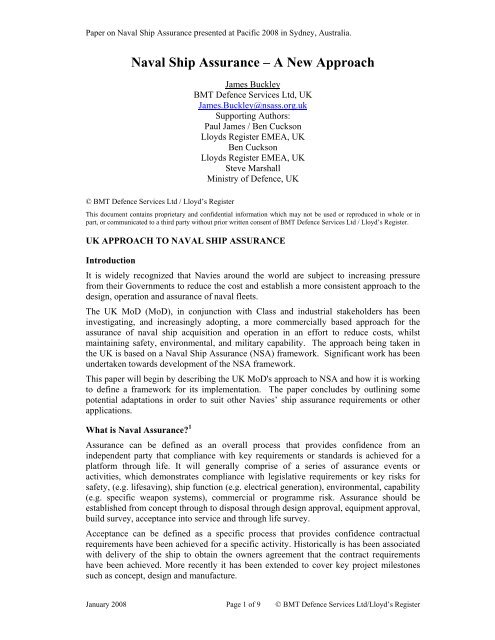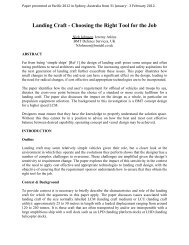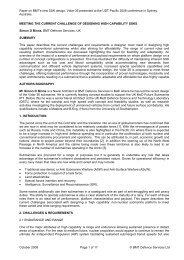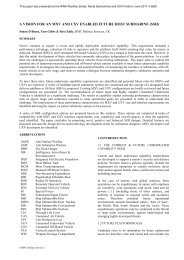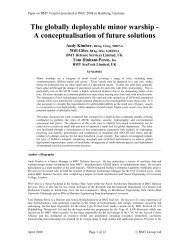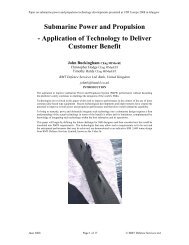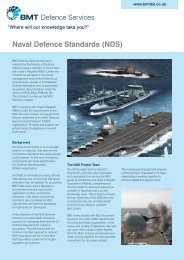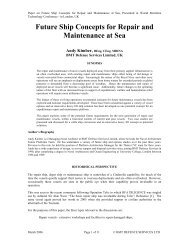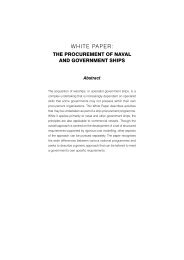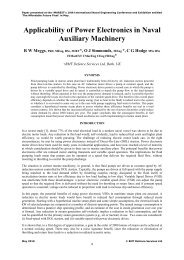Naval Ship Assurance â A New Approach - BMT Defence Services
Naval Ship Assurance â A New Approach - BMT Defence Services
Naval Ship Assurance â A New Approach - BMT Defence Services
You also want an ePaper? Increase the reach of your titles
YUMPU automatically turns print PDFs into web optimized ePapers that Google loves.
Paper on <strong>Naval</strong> <strong>Ship</strong> <strong>Assurance</strong> presented at Pacific 2008 in Sydney, Australia.Tailoring General Requirements to <strong>Ship</strong> SpecificationsWith reference to Figure 1 below, the framework consists of a central cone that makes thelink between the capability requested by the customer and the capability delivered in theplatform. At the top of the central cone is the customer requirement input - i.e.requirements from Director Equipment Capability (DEC). Working down the cone, this istranslated, through the procurement process of preparing general naval requirements andgeneral system specifications, to produce detailed system specifications that can becontracted against.Figure 1 - <strong>Naval</strong> <strong>Ship</strong> <strong>Assurance</strong> FrameworkThe process for developing the General <strong>Naval</strong> Requirements into a set of General SystemSpecifications and Detailed System Specifications is aided by the General <strong>Naval</strong>Specification document (GNS).A key benefit of using the General <strong>Naval</strong> Specification as a template is the incorporation oflearning from experience and so avoiding costly mistakes that are a repeat of history.The General <strong>Naval</strong> Specification supports the layers of the specification process, soproviding the ability to exit at different levels appropriate to the procurement process andthe shipbuilding contractual arrangement.With reference to the central cone, for the 1st layer down from the customer the General<strong>Naval</strong> Specification document provides a template for a project team to develop their owntailored and specific User Requirement and System Requirement documents. Use of thistemplate aids the project team to ensure that the output is comprehensive and coherent. Ifallied across a Navy it will provide consistency and provides a place to store lessonslearned from experience.January 2008 Page 3 of 9 © <strong>BMT</strong> <strong>Defence</strong> <strong>Services</strong> Ltd/Lloyd’s Register
Paper on <strong>Naval</strong> <strong>Ship</strong> <strong>Assurance</strong> presented at Pacific 2008 in Sydney, Australia.In the 2nd and 3rd layers, the General <strong>Naval</strong> Specification document provides a templatefor a project team to take the User and System Requirements to develop systemspecifications, which are then developed into detailed system specifications that couldform the basis of contracting. Implicit in these levels are the development of acceptancecriteria against the requirements.At the core of the central cone is the backbone of Deep Design Knowledge. This is aknowledge base that aids the generation of the capability requirements, throughdevelopment of the User Requirements and System Requirements and down to finalacceptance of the ship / submarine into service.A key part of this design knowledge base is the Maritime Platform Characteristics (MPCs).These enable the 'sponsor' to define the 'attributes' that they expect the solution to therequirements set to exhibit. It is not the function of MPCs to tell the project teamdelivering a new capability how to derive its solution; however, they provide a check listagainst which any solution could be assured. In addition, MPCs contain a wealth ofinformation that can be accessed by the project team to help ensure they are on the righttrack when working their way towards the specification tailored for that platform.Another example of the content of this design knowledge base is ship specific designknowledge which aids the project team in developing the specification; for example theLanding Craft Design Guide, Guide to the <strong>Naval</strong> <strong>Ship</strong> Code, Stability for Surface <strong>Ship</strong>Acquisition publication MAP01-024. Other content might cover systems, functions orstages of the procurement process.Tailoring Lenses of the FrameworkFigure 2 - Applying the Safety LensAround the central cone (in Figure 1) are lenses defining the codes and standards usedthroughout the design process. The lenses can be viewed from either direction.January 2008 Page 4 of 9 © <strong>BMT</strong> <strong>Defence</strong> <strong>Services</strong> Ltd/Lloyd’s Register
Paper on <strong>Naval</strong> <strong>Ship</strong> <strong>Assurance</strong> presented at Pacific 2008 in Sydney, Australia.<strong>Naval</strong> <strong>Assurance</strong> Framework TemplateFrameworkdocumentGeneral<strong>Naval</strong>SpecificationLevel Title FrameworkstandardUserRequirementDocumentSystemRequirementDocument<strong>Ship</strong>SpecificationSystemSpecificationOperationalAreaPlatformStructureStructureFatigueNotApplicableNotApplicable<strong>Naval</strong> <strong>Ship</strong>RulesFDAProceduresProject Specific RequirementsRequirements4000 Days NorthAtlanticFatigueassessmentFDA NotationFDA2 Spectralfatigue analysisFDA3 at 8detailed locationsCriteriaClassificationcertificateDesign appraisalEnhanced surveyduring buildCM notationThrough LifeManagementPlanStructureFatigue<strong>Naval</strong>SurveyGuidanceSurvey of CMpointsClassificationSurveyTable 1 - Implementing the Framework - An ExampleNot redefining ship designThe framework is not a redefinition of the ship design process and it is not intending tocreate new processes but to provide a structure for processes that should already beconducted; for guiding project teams as they collate the evidence for assurance andconsider the evidence holistically.Using the frameworkThe framework provides an opportunity to map out key requirements for a project anddevelop a baseline requirements/standards set upon which cost capability discussions cantake place. If the framework is used consistently within a Navy from project to project,these decisions can be benchmarked against legacy projects or at the time of a mid lifeupgrade, against the original design intent.Some areas of the framework will have mandatory requirements that relate to safety orenvironmental compliance. It is important that these are clearly identified. They may welldiffer between navies and will certainly evolve over time in the same way that commerciallegislation changes. Tailoring of the mandatory requirements can occur but, generally,equivalent levels of performance will have to be demonstrated.For other areas, mandatory performance or capability requirements can be specified but aNavy will need to exercise extreme care when doing this, as mandatory capability candrive project cost. It may be better to specify minimum and desired capability.Many requirements will be optional and need to be negotiated during the development of aproject; the framework offers a consistent and familiar basis on which to do so.For example, the framework has a place holder for a steering system. The framework willidentify mandatory requirements for safety e.g. Redundancy and rate of turn (NSR Vol IIJanuary 2008 Page 6 of 9 © <strong>BMT</strong> <strong>Defence</strong> <strong>Services</strong> Ltd/Lloyd’s Register
Paper on <strong>Naval</strong> <strong>Ship</strong> <strong>Assurance</strong> presented at Pacific 2008 in Sydney, Australia.Pt6 Ch1) but also performance maintenance and operability requirements (GNS Ref Part 1- S2329/2330 Manoeuvring and Part 2 - 508 Steering Systems and Stabilisation Systems).A decision has to be made about the type and specification of the steering gear on thisparticular project and this can be recorded in the framework. Ultimately this will form thespecification for the ship builder but it can also be used to identify assurance activities(class equipment certificate), acceptance events (test and trials) and record the decisionprocess.Ten years later when there is a plan to upgrade the capability of the ship the framework canbe a reference for the original design intent. The upgrade can then be assessed as compliantor demonstrated as an improvement on that original intent. In a parallel project theframework can be used to clarify requirements which could be copied or used as a benchmark for a new solution.This example demonstrates use of the framework at a low level (specification level), butsimilar principles can be applied at a higher level in the framework (user requirementlevel)Applicability to in serviceIn implementing this approach to assist managing naval assurance it is important that it isof use not only to the new build project team but also to the in-service project team,particularly for those making significant mid life upgrades but also in support of generaloperation. In essence it needs to provide support to project teams understanding how theynavigate their way to collate the necessary assurance as part of their through life capabilitymanagement in whatever form that management might take place. When in-serviceexperience demonstrates particular maintenance problems the lessons learned can be storedin a guidance document for use within the framework, to benefit future projects. Wherethere is a failure, due to an unforeseen mode of operation, design rules within theframework can be updated.NAVAL SHIP ASSURANCE SUPPORT SERVICE - NSASSBackground<strong>BMT</strong> and LR have formed an alliance with the MoD to support them in developing,managing and enhancing the framework for naval ship specifications, standards andassurance; the NSA framework.In addition NSASS will undertake tasks to populate the framework, either through thedevelopment of specific standards or contributing to existing standards through establishedmaintenance processes.The identified need arose from the MoD Sea Systems Group, focused predominantly onsafety and the key hazard certificates. The <strong>Naval</strong> <strong>Ship</strong> <strong>Assurance</strong> Support Service hasbeen borne out of this requirement.Whilst <strong>Naval</strong> <strong>Assurance</strong> is significantly wider than the framework for key hazard safetyassurance “<strong>Naval</strong> <strong>Assurance</strong> is about providing the overall assurance underpinningThrough Life Capability Management”, the alliance through NSASS provides a route toimplement the framework's safety aspects on behalf of the MoD.The broad remit for NSASS is captured in the following objectives:Key Objective 1 - Develop a framework for ship safety assurance that is coherent,comprehensive and clear.January 2008 Page 7 of 9 © <strong>BMT</strong> <strong>Defence</strong> <strong>Services</strong> Ltd/Lloyd’s Register
Paper on <strong>Naval</strong> <strong>Ship</strong> <strong>Assurance</strong> presented at Pacific 2008 in Sydney, Australia.Key Objective 2 - Continuously monitor and improve the framework.Key Objective 3 - Make the framework accessible to MoD regulatory bodies, MoDIntegrated Project Teams and Industry and provide guidance for effective navigation.Within this is the role of influencing the key document sets that populate the framework.This includes the General <strong>Naval</strong> Specification (GNS), <strong>Naval</strong> <strong>Ship</strong> Code (NSC), LR <strong>Naval</strong><strong>Ship</strong> Rules (LR NSR) and <strong>Naval</strong> Standards.There are already well defined mechanisms for the maintenance and development of thesedocument sets and the role of NSASS is not to duplicate or contravene these but to provideinput through established processes based on lessons learned from application of theframework and standards in a project. NSASS has a role to understand the place andboundaries of new standards within the framework plus take an holistic view of navalassurance and review the standards set for completeness, coherency and clarity.Benefits Brought by NSASSThe key benefits in supporting the NSA framework through the NSASS arrangement are:The NSASS team directly involves Commercial and <strong>Defence</strong> personnel, with experience ofspecification and standard development and implementation, working on the generationand consolidation of the framework;The NSASS supports alignment of non-MoD frameworks (i.e. Commercial models) withbespoke MoD processes, to reduce the long term risk of divergence;Through NSASS, key industry standards and specialist design development knowledge andcapability is provided as a managed input to the NSA framework;Through NSASS, experienced manpower, is focused and made available to provideframework development, implementation and specification / standards development workwhich continuously improves and assists the implementation of an effective NSAframework.<strong>BMT</strong> and LR have a strong and long record of achievement and pedigree in the provisionof the document sets that underpin the NSA framework. This collaboration of our twoorganisations delivers an in depth understanding of the challenges presented by theassurance of naval surface ships.ADAPTING THE NAVAL SHIP ASSURANCE FRAMEWORK FOR OTHERAPPLICATIONS AND NATIONSSubmarinesWhilst the NSA framework has been developed in the context of surface ships, it has alsodeliberately been constructed to ensure that the overall concept and high level frameworkis as applicable to submarines. At the detailed level the specific documents and guidancefor project teams will be different but the overall issues and routes to providing assuranceare similar.Work is currently ongoing to explore the development of a submarine General <strong>Naval</strong>Specification. There are also class naval rules for submarines.As yet there is not a submarine version of <strong>Naval</strong> <strong>Ship</strong> Code however this does not preventapplication of the framework as the lens can be developed to interface with existing <strong>Naval</strong>Authority policy and standards prior to such a document being generated.January 2008 Page 8 of 9 © <strong>BMT</strong> <strong>Defence</strong> <strong>Services</strong> Ltd/Lloyd’s Register
Paper on <strong>Naval</strong> <strong>Ship</strong> <strong>Assurance</strong> presented at Pacific 2008 in Sydney, Australia.Other NationsThe framework has also been developed to make it generic enough that at the high levelframework it is not specific to an individual country's situation. So the framework concepthas been depicted in a way that recognizes there is a process for developing the customerrequirements into a specification and a physical product and that this is within the contextof a regulatory system.NSASS can work with any navy to take the high level requirement and develop the lowerlevels of the framework to incorporate a navy’s specific policies and standards.The terminology is purposefully generic that the country specific terminology can beinserted, together with the country specific composition of policy and standards.Generic Placeholders in the FrameworkIn essence the framework is designed to provide a concept and mechanism for depictingthe assurance situation and almost a ‘plug and play’ approach to generating a countryspecific solution. The detail has to be developed to ensure that the adapted framework iscomprehensive, coherent and clear.CONCLUSIONComprehensiveness, Coherency and Clarity in Supporting <strong>Assurance</strong>This <strong>Naval</strong> <strong>Assurance</strong> Framework is for the overall assurance of Through Life CapabilityManagement, encompassing: Safety, Environment, Operability, Supportability,Affordability and Programme.The framework brings together the elements of naval assurance into a coherent structure toenable the user to identify how to apply the requirements, codes and standards and ispertinent to both submarines and surface ships.The key drivers for an effective framework are that it is comprehensive, coherent andprovides clarity to the regulators and project teams.The alliance through NSASS provides a route to implement the framework's safety aspectson behalf of the MoD. It is in its early days of developing this framework and adapting itin light of experience of its use in implementation on new procurement and in-serviceships, and is beginning exploration of its transfer into submarine assurance.The MoD has travelled a long way in adopting a more commercially based approach fornaval assurance. The NSASS alliance is the next stage in that journey. There remainssignificant ground to be covered as the <strong>Naval</strong> <strong>Ship</strong> <strong>Assurance</strong> Framework is implemented.The NSASS team would be interested in receiving feedback that the reader, may have inrelation to naval assurance in your situation, as we tackle an issue that affects many navies.Please make contact with the authors through the NSASS team:Email: enquiries@nsass.org.uk Website: www.nsass.org.uk Tel: +44 (0)1225 473572REFERENCES1 Rudgley R (2006) <strong>Naval</strong> <strong>Ship</strong> Specifications, Standards and <strong>Assurance</strong>: A newframework - UK MoD Sea Systems Group Poster - Issue 04.2 Rudgley R (2006) <strong>Naval</strong> <strong>Ship</strong> Specifications, Standards and <strong>Assurance</strong>. UK MoD SeaSystems Group Reference SSG/181/4/1/1/1 - 23 September 2006.January 2008 Page 9 of 9 © <strong>BMT</strong> <strong>Defence</strong> <strong>Services</strong> Ltd/Lloyd’s Register


